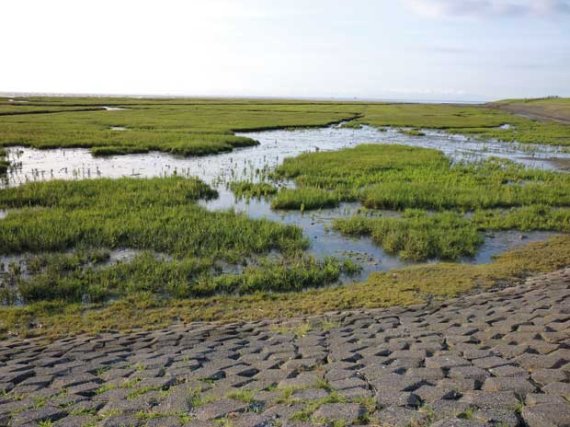Salt marshes for flood protection is the title of the thesis for which Jantsje van Loon-Steensma received her PhD on Wednesday 8 October. Van Loon-Steensma studied saltwater transitional zones between sea and land, or salt-marsh forelands, as she prefers to call them. The vegetation in these forelands is rich in beautiful and dynamic flora and fauna. The islands of the Wadden Sea are a marvellous example.
But as well as being beautiful, salt marshes have their uses. They serve as breakwaters, making them interesting for coastal defence. Van Loon-Steensma explored the potential of such foreland vegetation in the Wadden region. The aim is to make the existing dikes more robust by combining the functions of nature conservation and landscape with coastal protection. From a range of possibilities, she focused mainly on vegetation in the foreland in front of the dike.
Habitat
Salt marshes develop in shallow water where there is little movement and a lot of sediment. That sediment sinks and forms a layer of clay on which specific vegetation grows which helps to further raise the zone in front of the dike. Salt marshes occur spontaneously, but you can give the process a helping hand. ‘By making dams out of twigs or clay, for instance, you can create places where there are not many waves.’ Under the right conditions, a flourishing salt marsh can then establish itself within a couple of decades. Land has been reclaimed for centuries by empoldering salt marshes for agricultural use. This is how the Netherlands literally expanded.
Since the nineteen seventies, the emphasis has shifted to reclaiming land for nature-related purposes. Salt marshes represent a unique habitat. Their function as a breakwater adds a new dimension to this. To some extent it is possible to calculate the extent of this function, and Van Loon-Steensma did this for a salt marsh of about four hectares at the Striep polder on Terschelling island. Calculations (see box) show that a densely overgrown salt marsh of 350 metres wide can reduce the height of waves by three quarters. A bare salt marsh, by contrast, breaks the waves much less.
‘Besides the extent and the height of the salt marsh, then, the vegetation really does make a difference too. Vegetation creates friction, which calms down the waves. That is an interesting topic for further research,’ thinks Van Loon-Steensma. Salt marshes are not equally covered in vegetation all year round. From the point of view of coastal defence, that is a considerable disadvantage. Moreover, salt marshes are a dynamic ecosystem, which is another uncertainty factor from the safety angle. Calculations show, for instance, that without intervention the Striep will have disappeared by 2050.
Green dike
Van Loon-Steensma’s favourite dike is what is known as a broad green dike. This is a traditional dike which slopes gently on the seaward side and is completely covered in grass. ‘The slope on a normal dike is one in three or four,’ she explains. ‘On this one that gradient is smaller, about one in seven. You add an extra layer of clay and cover the whole thing with grass. The idea is that the waves break on the green slope. You do have to combine the dike with a salt marsh which breaks the waves. Then in a real storm, the green slope can cope.’
Broad green dikes fit well into the Wadden region landscape, in Van Loon-Steensma’s view. Dikes covered in stones or asphalt literally turn green. The green dikes are also relatively inexpensive. ‘You don’t have to replace a single stone, just to add clay. That is relatively easy and cheap. You can even get the clay you need out of salt marshes. It used to be done like that in the old days too: the dikes were raised using clay from the salt marshes. In some places there is so much sediment that the marshes are growing faster than the sea level is rising.’
Germany already has broad green dikes. According to Van Loon-Steensma, there are ideas about making the Dutch dikes along the Dollard broad and green. The use of salt marshes to make dikes robust is promising, she says. ‘My idea is: make them extra robust. More robust than strictly necessary. Then you know you’ve done enough for the time being, regardless of which climate change scenario you take as your basis.’ But in the end, salt marshes are not a one-stop solution to rising sea levels. ‘In the end you cannot avoid having to raise the dikes. Salt marshes grow with the sea level, but dikes don’t.’

Fragile
Plants break waves. Jantsje van Loon-Steensma used a wave simulation model to calculate the wave-breaking effect in the Striep salt marsh on the island of Terschelling. On the basis of data about wind, waves, soil profile and vegetation (the thickness, density and height of stems), the model calculates on the spot how much a particular wave will be dampened. On the Striep marsh, dense vegetation had a dampening effect of 0.22 percent per metre. A marsh of 350 metres in breadth therefore reduces the height of a wave by a full three quar-ters. There is no guarantee that it really works like that at high tide, though. The model assumed normal wave height and water depth, so the figures would be different in a heavy or extreme storm.
Scope for salt marshes
The Wadden region (both mainland and islands) features 227 kilometres of dikes. Along about one third of these dikes there are already salt marshes, varying in breadth from a couple of metres to more than one kilometre. Along another one third of the dikes, it would seem possible to create salt marshes with varying degrees of effort. This could affect the Wadden Sea, however, which is a protected habitat in its own right. Along the remaining one third of the dikes, it would not be possible to create salt marshes, often because there is too much current for sediment to settle.

